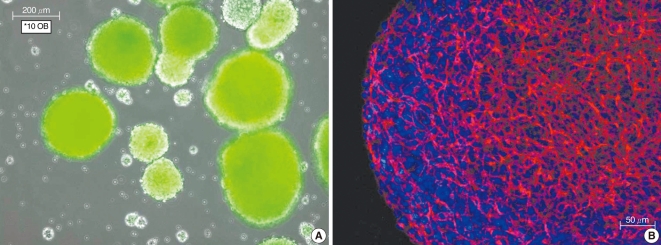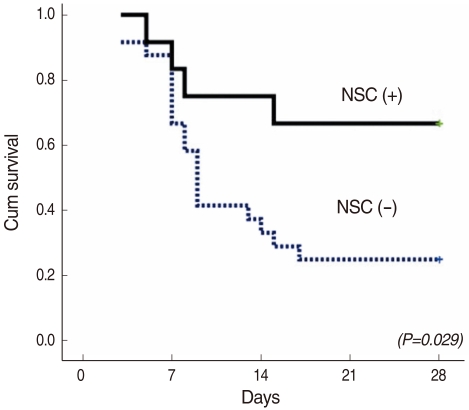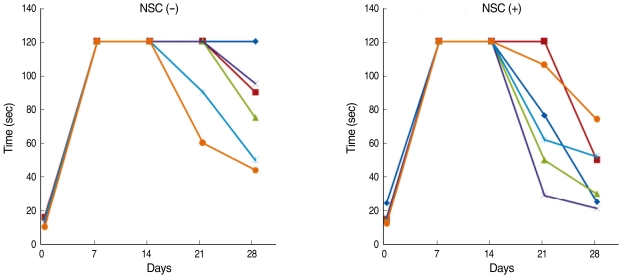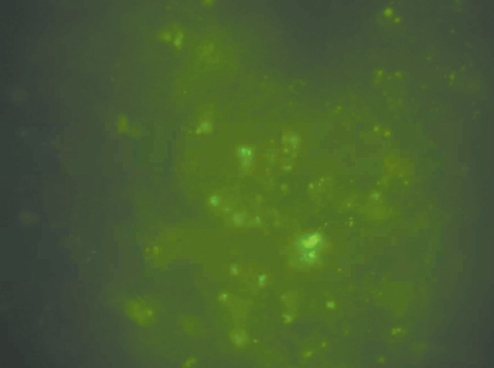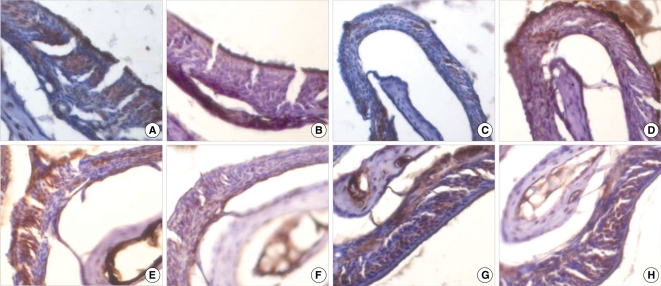Clin Exp Otorhinolaryngol.
2010 Jun;3(2):84-90. 10.3342/ceo.2010.3.2.84.
Transplantation of Neural Stem Cells in Anosmic Mice
- Affiliations
-
- 1Department of Otorhinolaryngology, Seoul National University College of Medicine, Seoul National University Hospital, Seoul, Korea.
- 2Department of Otorhinolaryngology, Seoul National University College of Medicine, Seoul National University Bundang Hospital, Seongnam, Korea. kimemail@snubh.org
- 3Sensory Organ Research Institute, Medical Research Center, Seoul, Korea.
- KMID: 1460594
- DOI: http://doi.org/10.3342/ceo.2010.3.2.84
Abstract
OBJECTIVES
Treating olfactory dysfunction is a challenge for physicians. One of the therapeutic options could be transplantation of stem cells. In this study, neural stem cells were transplanted into anosmic mice.
METHODS
Neural stem cells were generated from the olfactory bulb of green fluorescent protein (GFP)-transgenic C57BL6 mice. Anosmia were induced by injection of intraperitoneal 3-methylindole. The neural stem cells were transplanted transnasally on the next day. The olfactory function was evaluated by a food-finding test once a week. The olfactory neuroepithelium was harvested for histologic examination and protein analysis at 4 weeks.
RESULTS
Twenty-five percent (6/24) of the control mice that were not transplanted with neural stem cells survived at 4 weeks while 67% (8/12) of the transplanted mice survived (P=0.029). The food finding test showed that the transplanted mice resumed finding food at 3 weeks while the control mice resumed finding food at 4 weeks. GFP-positive cells were observed in the olfactory neuroepithelium of the transplanted mice. Western blotting revealed that the olfactory marker protein expression was significantly lower in the control mice than that in the transplanted mice.
CONCLUSION
This study demonstrated that improvement of mouse survival was achieved and recovery of olfactory function was promoted by transnasal transplantation of neural stem cells in the anosmic mouse model. These results indicate that stem cells might be one of the future modalities for treating olfactory impairment.
Keyword
MeSH Terms
Figure
Reference
-
1. Lin SH, Chu ST, Yuan BC, Shu CH. Survey of the frequency of olfactory dysfunction in Taiwan. J Chin Med Assoc. 2009; 2. 72(2):68–71. PMID: 19251533.
Article2. Doty RL. The olfactory system and its disorders. Semin Neurol. 2009; 2. 29(1):74–81. PMID: 19214935.
Article3. Buck L, Axel R. A novel multigene family may encode odorant receptors: a molecular basis for odor recognition. Cell. 1991; 4. 65(1):175–187. PMID: 1840504.
Article4. Nordin S, Bramerson A. Complaints of olfactory disorders: epidemiology, assessment and clinical implications. Curr Opin Allergy Clin Immunol. 2008; 2. 8(1):10–15. PMID: 18188011.
Article5. Beites CL, Kawauchi S, Crocker CE, Calof AL. Identification and molecular regulation of neural stem cells in the olfactory epithelium. Exp Cell Res. 2005; 6. 306(2):309–316. PMID: 15925585.
Article6. Iwai N, Zhou Z, Roop DR, Behringer RR. Horizontal basal cells are multipotent progenitors in normal and injured adult olfactory epithelium. Stem Cells. 2008; 5. 26(5):1298–1306. PMID: 18308944.
Article7. Dimmeler S, Zeiher AM. Cell therapy of acute myocardial infarction: open questions. Cardiology. 2009; 113(3):155–160. PMID: 19122455.
Article8. Andres RH, Choi R, Steinberg GK, Guzman R. Potential of adult neural stem cells in stroke therapy. Regen Med. 2008; 11. 3(6):893–905. PMID: 18947311.9. Ahn JM, Lee CH, Kim DY, Rhee CS, Min YG, Kim JW. Maintenance of regional difference in cellular composition of neurospheres derived from adult mouse olfactory bulb. Eur Arch Otorhinolaryngol. 2008; 4. 265(4):429–434. PMID: 17938947.
Article10. Kim SU, de Vellis J. Stem cell-based cell therapy in neurological diseases: a review. J Neurosci Res. 2009; 8. 87(10):2183–2200. PMID: 19301431.
Article11. Madhavan L, Daley BF, Paumier KL, Collier TJ. Transplantation of subventricular zone neural precursors induces an endogenous precursor cell response in a rat model of Parkinson's disease. J Comp Neurol. 2009; 7. 515(1):102–115. PMID: 19399899.
Article12. Greene P. Cell-based therapies in Parkinson's disease. Curr Neurol Neurosci Rep. 2009; 7. 9(4):292–297. PMID: 19515281.
Article13. Lindvall O, Kokaia Z. Prospects of stem cell therapy for replacing dopamine neurons in Parkinson's disease. Trends Pharmacol Sci. 2009; 5. 30(5):260–267. PMID: 19362379.
Article14. Xuan AG, Luo M, Ji WD, Jin WD, Long DH. Effects of engrafted neural stem cells in Alzheimer's disease rats. Neurosci Lett. 2009; 1. 450(2):167–171. PMID: 19070649.
Article15. Mimeault M, Batra SK. Recent progress on tissue-resident adult stem cell biology and their therapeutic implications. Stem Cell Rev. 2008; Spring. 4(1):27–49. PMID: 18288619.
Article16. Franceschini V, Bettini S, Pifferi S, Rosellini A, Menini A, Saccardi R, et al. Human cord blood CD133+ stem cells transplanted to nodscid mice provide conditions for regeneration of olfactory neuroepithelium after permanent damage induced by dichlobenil. Stem Cells. 2009; 4. 27(4):825–835. PMID: 19350683.
Article17. Kim YM, Choi YS, Choi JW, Park YH, Koo BS, Roh HJ, et al. Effects of systemic transplantation of adipose tissue-derived stem cells on olfactory epithelium regeneration. Laryngoscope. 2009; 5. 119(5):993–999. PMID: 19296495.
Article18. Tsujigiwa H, Nishizaki K, Teshima T, Takeda Y, Yoshinobu J, Takeuchi A, et al. The engraftment of transplanted bone marrow-derived cells into the olfactory epithelium. Brain Res. 2005; 8. 1052(1):10–15. PMID: 15996641.
Article
- Full Text Links
- Actions
-
Cited
- CITED
-
- Close
- Share
- Similar articles
-
- Neural Stem Cells for Neurological Disorders
- Current Concepts of Stem Cell Therapy
- Transplantation of neural stem cells: cellular & gene therapy for hypoxic-ischemic brain injury
- Clinical Applications of Neural Stem Cells for the Treatment of Peripheral Neuropathy
- Establishment of a Method for Cryopreservation of Neural Stem Cells

